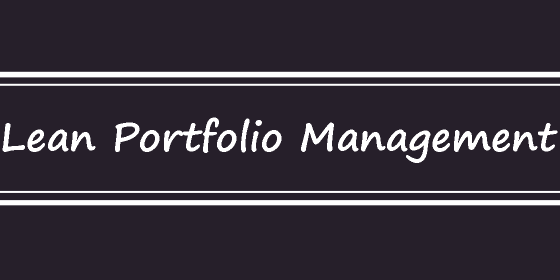Lean Portfolio Management

Lean Portfolio Management (LPM) is an Agile approach to managing a portfolio of projects, initiatives, and products within an organization. It aims to align the organization’s strategy, investment decisions, and execution with Lean-Agile principles to deliver valuable products and services efficiently.
Key components and principles of Lean Portfolio Management include:
- Value Stream Alignment: LPM focuses on identifying and aligning value streams with the organization’s strategic goals. Value streams represent the end-to-end flow of activities required to deliver value to customers.
- Lean Budgeting: LPM involves Lean budgeting practices that prioritize funding based on value, outcomes, and customer needs. It aims to move away from traditional fixed budgets and allocate funds dynamically based on actual performance and progress.
- Portfolio Vision: LPM establishes a clear and shared vision for the portfolio that guides decision-making and prioritization of initiatives.
- Lean Portfolio Canvas: The Lean Portfolio Canvas is a visual tool used to capture and communicate the portfolio’s strategic themes, initiatives, objectives, and key performance indicators (KPIs).
- Agile Portfolio Operations: LPM applies Agile practices and principles to portfolio-level activities, including governance, project prioritization, and resource allocation.
- Lean-Agile Budgeting: Lean-Agile budgeting practices are employed to fund value streams and initiatives incrementally and adaptively based on feedback and outcomes.
- Continuous Value Delivery: LPM emphasizes continuous value delivery by aligning development and operational efforts to deliver frequent, small increments of value.
- Portfolio Kanban: Portfolio Kanban boards are used to visualize and manage the flow of portfolio initiatives, helping identify bottlenecks and improve flow efficiency.
- Lean-Agile Leadership: LPM requires leadership to adopt a Lean-Agile mindset, promote a culture of innovation, and foster collaboration among different parts of the organization.
- Lean Portfolio Governance: Lean Portfolio Governance focuses on setting clear guardrails and providing strategic guidance to teams while allowing them autonomy in execution.
Lean Portfolio Management is especially beneficial for large enterprises and organizations that have a substantial number of projects, initiatives, and product development efforts. By adopting Lean-Agile practices at the portfolio level, organizations can enhance their ability to respond to changing market conditions, optimize resource allocation, and ensure that the right initiatives are prioritized and delivered to achieve the desired outcomes.
Implementing Lean Portfolio Management requires collaboration among various stakeholders, including business leaders, product owners, Agile teams, and finance departments, to ensure that strategic objectives are aligned, and value delivery is maximized throughout the organization.